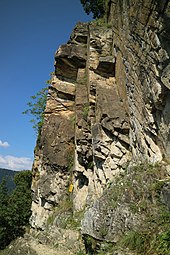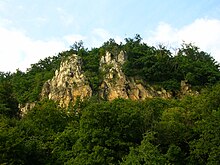Admonter Kogel
| Admonter Kogel | ||
|---|---|---|
|
View from the southeast |
||
| height | 566 m above sea level A. | |
| location | Styria , Austria | |
| Mountains | Grazer Bergland , foothills east of the Mur | |
| Dominance | 1 km → Kanzelkogel | |
| Notch height | 56 m ↓ Kanzelsattel | |
| Coordinates | 47 ° 6 '51 " N , 15 ° 23' 50" E | |
|
|
||
| rock | Steinbergkalk , Dolomite | |
| Age of the rock | Upper Devonian | |
| particularities | Andritz-Weinzödl climbing garden | |
The Admonter Kogel is 566 m above sea level. A. high hill in the Grazer Bergland in the Austrian state of Styria . It is located in the north of the provincial capital Graz and is known for the location of the Andritz-Weinzödl climbing garden.
Location and surroundings
The Admonter Kogel rises west of the district of St. Veit , from which it is separated by the Falkenbach, in the Graz district of Andritz . Together with the Kanzelkogel ( 615 m ) sloping west to the Middle Murtal, it forms a southern branch of the Hohen Rannach, and with the Göstinger Ruinsberg on the other bank of the Mur, it forms the point where the Murtal opens to the Grazer Feld . At the immediate south foot of the mountain is the St. Gotthard Castle and a few hundred meters away the Graz-Weinzödl sports center and the heavily frequented intersection of the B 67 . The hill is part of the landscape protection area of the northern and eastern hill country of Graz (LSG-30) and houses a protected rock pear population (GLT-1301) on its southern flank .
Geology and geomorphology
The Admonter Kogel belongs to the Graz Paleozoic Era and consists mainly of Upper Devonian Steinberg limestone on the surface . It is a colored, light gray, yellowish, brownish, red or purple, partly dolomitic limestone with clayey, glimmering skins on the layer surfaces . Strong lensing as well as clear deformation of the macrofossils indicate a strong movement of the layers. Microfacially , the rock consists of micrites to biomicrites. The thickness fluctuates regionally, as the Upper Devon is only fully developed in a few places in the Grazer Bergland. In addition, dolomite sandstones and diabase of the Rannach facies can be found on the Admonter Kogel .
The continuously forested mountain is interspersed with rocks to the south, while the north side , which is determined by Miocene sediments, slopes moderately steeply towards the Pailgraben. The summit area has a certain plateau character, which, according to Arthur Winkler-Hermaden, can be traced from the Florianiberg to Leoben as it rises above sea level . The geologist summarized these planed areas as the Stadelberg level.
Weinzödl climbing garden
The Andritz-Weinzödl climbing garden on its southern flank makes the Admonter Kogel famous . Between 80 and 90 routes of various degrees of difficulty have been laid out on the dolomite rocks . The wall height is between 10 and 30 m. At the foot of the wall there is the possibility of a long boulder traverse. The short approach time and numerous easy climbing routes (up to 6 degrees) make the rocks on the sunny side popular with beginners.
Due to loose rock there has been a risk of falling rocks for years . The Alpine Club strives for the care rights and has been expressly warning on its website since 2015 against the use of the climbing garden.
Web links
Individual evidence
- ↑ Landscape protection area No. 30. State of Styria , accessed on July 22, 2018 .
- ↑ Protected parts of the landscape. State of Styria , accessed on July 23, 2018 .
- ↑ Helmut wing : The geology of the Grazer Bergland. In: Communications from the Department of Geology, Paleontology and Mining at the Landesmuseum Joanneum , Graz 1975, pp. 49–50. Online PDF , accessed May 28, 2019.
- ↑ Digital Atlas of Styria: Geology & Geotechnics. State of Styria , accessed on July 22, 2018 .
- ↑ Wing, p. 130.
- ^ Andreas: Andritz Weinzödl Graz. bergstieg.com, accessed on July 23, 2018 .
- ↑ Weinzödl climbing garden: Alpenverein Graz warns of the risk of falling rocks. Alpine Club Austria , July 13, 2015, accessed on July 23, 2018 .



